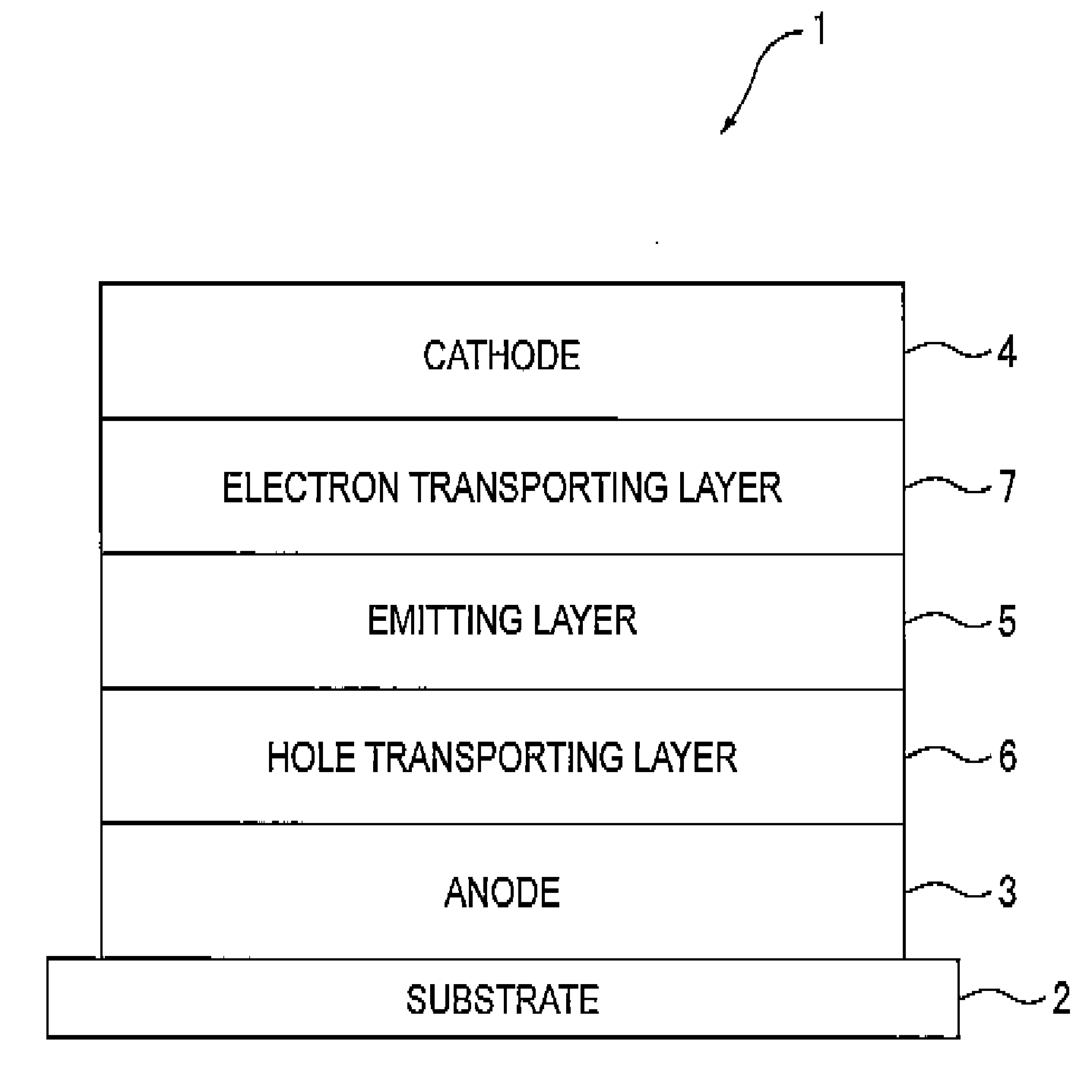Diaminopyrene derivative and organic el device using the same
a diaminopyrene and organic el technology, applied in thermoelectric devices, group 3/13 element organic compounds, germanium organic compounds, etc., can solve the problem of unfavorable longer wavelength of fluorescence obtained from molecular aggregates and single molecules, and achieve enhanced luminous efficiency, high luminous efficiency, and increased emission lifetime
- Summary
- Abstract
- Description
- Claims
- Application Information
AI Technical Summary
Benefits of technology
Problems solved by technology
Method used
Image
Examples
synthesis example 1
Synthesis of Compound (d-15)
[0228]Under argon stream, 4.4 g (10 mmol) of 3,8-diisopropyl-1,6-dibromopyrene, 7.8 g (25 mmol) of bis(4-trimethyl silylphenyl) amine, 0.033 g (0.15 mmol) of palladium acetate, 0.061 g (0.3 mmol) of tri-t-butylphosphine, 2.4 g (25 mmol) of sodium t-butoxide and 100 mL of dry toluene were put into a three-neck flask of 300 mL having a cooling pipe, and stirred at 100 degrees C. for a night while heated. On completion of the reaction, the precipitated crystal were separated by filtration and cleaned with 50 mL of toluene and 100 mL of methanol. Then, 8.2 g of light yellow powder was obtained. This powder was identified as the compound (d-15) as a result of measurement of 1H-NMR spectrum and FD-MS (field desorption mass spectrum). The yield was 80%. 1H-NMR spectrum was measured with DRX-500 manufactured by Brucker Corporation (solvent of perchloromethylene).
[0229]FIG. 2 shows the measured 1H-NMR spectrum, and FIGS. 3A and 3B are magnified views of FIG. 2. FI...
synthesis example 2
Synthesis of Compound (d-8)
[0231]Under argon stream, 3.8 g (10 mmol) of 3,8-dimethyl-1,6-dibromopyrene, 6 g (25 mmol) of 4-trimethylsilyl diphenylamine, 0.033 g (0.15 mmol) of palladium acetate, 0.061 g (0.3 mmol) of tri-t-butylphosphine, 2.4 g (25 mmol) of sodium t-butoxide and 100 mL of dry toluene were put into a three-neck flask of 300 mL having a cooling pipe, and stirred at 100 degrees C. for a night while heated. On completion of the reaction, the precipitated crystal were separated by filtration and cleaned with 50 mL of toluene and 100 mL of methanol. Then, 5.6 g of light yellow powder was obtained. This powder was identified as the compound (d-8) as a result of measurement of 1H-NMR spectrum and FD-MS. The yield was 80%. The maximum absorption wavelength measured in a solution of toluene with respect to the obtained compound was 425 nm.
[0232]FIG. 4 shows the emission spectrum of the obtained compound. The maximum fluorescence wavelength was 459 nm.
example 1
[0233]A transparent electrode made of indium tin oxide was provided onto a glass substrate (size: 25 mm×75 mm×1.1 mm) to be 120 nm thick. The transparent electrode served as the anode.
[0234]Subsequently, the glass substrate was cleaned with irradiation of ultraviolet and ozone, and mounted on a vacuum deposition equipment.
[0235]N′,N″-bis[4-(diphenylamino)phenyl]-N′,N″-diphenylbiphenyl-4,4′-diamine was initially deposited to be 60 nm thick (serving as the hole injecting layer), and then N,N,N′,N′-tetrakis(4-biphenyl)-4,4′-benzidine was deposited to be 20 nm thick (serving as the hole transporting layer). Subsequently, 10,10′-bis[1,1′,4′,1″]terphenyl-2-yl-9,9′-bisanthracene as the host and the compound (d-15) as the doping material were simultaneously deposited at a mass ratio of 40 to 2, so that a 40-nm thick emitting layer was provided.
[0236]As the electron injecting layer, tris(8-hydroxyquinolinato) aluminum was deposited on the emitting layer to be 20 nm thick.
[0237]Next, lithium ...
PUM
| Property | Measurement | Unit |
|---|---|---|
| Energy | aaaaa | aaaaa |
Abstract
Description
Claims
Application Information
 Login to View More
Login to View More - R&D
- Intellectual Property
- Life Sciences
- Materials
- Tech Scout
- Unparalleled Data Quality
- Higher Quality Content
- 60% Fewer Hallucinations
Browse by: Latest US Patents, China's latest patents, Technical Efficacy Thesaurus, Application Domain, Technology Topic, Popular Technical Reports.
© 2025 PatSnap. All rights reserved.Legal|Privacy policy|Modern Slavery Act Transparency Statement|Sitemap|About US| Contact US: help@patsnap.com



